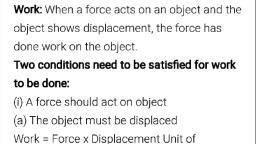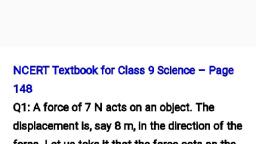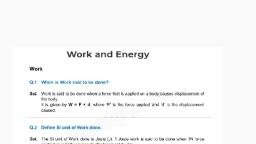Page 1 :
1. A force of 10 N acts on an object. The displacement is, say 8 m, in the direction of the, force. Let us take it that the force acts on the object through the displacement. What is the, , work done in this case?, , <— 8m ——>, 7x—> J Co, , Ans: When a force F acts on an object to displace it through a distance S in its direction,, then the work done W on the body by the force is given by:, , Work done = Force = Displacement, , W=Fxs, , where, F=7N,S=8m, , Therefore, work done, W=7 x 8 =56Nm =56J, , 1. When do we say that work is done?, Ans: Work is done whenever the given conditions are satisfied:, (i) A force acts on the body., (ii) There is a displacement of the body caused by the applied force along the direction of, the applied force., , 2. Write an expression for the work done when a force is acting on an object in the, direction of its displacement., Ans: When a force F displaces a body through a distance S in the direction of the applied, force, then the work done W on the body is given by the expression:, Work done = Force « Displacement, W=Fxs, , 3. Define 1 J of work., Ans: | J is the amount of work done by a force of 1 N on an object that displaces it through, a distance of | m in the direction of the applied force., , 4. A pair of bullocks exerts a force of 140 N on a plough. The field being ploughed is 15, m long. How much work is done in ploughing the length of the field?, Ans: Work done by the bullocks is given by the expression:, Work done = Force < Displacement, , , , , W=Fxd, , Where,, , Applied force, F = 140 N, Displacement, 15m, , W= 140 x 15=2100J, Hence, 2100 J of work is done in ploughing the length of the field., , 1. What is the kinetic energy of an object?, Ans:, Kinetic energy is the energy possessed by a body by the virtue of its motion. Every moving, object possesses kinetic energy. A body uses kinetic energy to do work. Kinetic energy of
Page 2 :
hammer is used in driving a nail into a log of wood, kinetic energy of air is used to run, wind mills, etc., , Write an expression for the kinetic energy of an object., Ans:, Ifa body of mass m is moving with a velocity v, then its kinetic energy E; is given by the, , « 1 3 —, expression, E; = pm". Its SI unit is Joule (J)., The kinetic energy of an object of mass, m moving with a velocity of 5 ms” is 25 J., What will be its kinetic energy when its velocity is doubled? What will be its kinetic, energy when its velocity is increased three times?, , Ans: Expression for kinetic energy is E, ot, , m= Mass of the object, , v= Velocity of the object = 5 m/s, , Given that kinetic energy, E, = 25 J, , (i) If the velocity of an object is doubled, then v= 5 x 2= 10 ms., , Therefore, its kinetic energy becomes 4 times its original value, because it is proportional, to the square of the velocity. Hence, kinetic energy = 25 x 4 = 100 J., , (ii) If velocity is increased three times, then its kinetic energy becomes 9 times its original, value, because it is proportional to the square of the velocity. Hence, kinetic energy = 25, 9225.5:, , What is power?, , Ans:, , Power is the rate of doing work or the rate of transfer of energy. If W is the amount of work, done in time t, then power is given by the expression,, , Work _ Energy W, , Power = >P=, , , , Time Time, It is expressed in watt (W)., , Define 1 watt of power., , Ans:, , 1 watt is the power of an agent, which does work at the rate of 1 joule per second., Power is 1 W when the rate of consumption of energy is | J/s., , 1 watt = | joule/second or 1 W= 1 Js., , A lamp consumes 1000 J of electrical energy in 10 s. What is its power?, Ans: Here, electrical energy consumption, W = 1000 J, time, t = 10 s., , Power = we = But =100W7, r 10, , , , Define average power., , Ans: A body can do different amount of work in different time intervals. Hence, it is better, to define average power. Average power is obtained by dividing the total amount of work, done in the total time taken to do this work., , total energy consumed, , Average power = :, total time taken
Page 3 :
LAW OF CONSERVATION OF ENERGYEnergy in a system may take on various, forms (e.g. kinetic, potential, heat, light). The law of conservation of energy, states that energy may neither be created nor destroyed. Therefore the sum of, all the energies in the system is a constant.The most commonly used example is, the pendulum:, , \, nT Og? Th, , The formula to calculate the potential energy is: PE = mgt], The mass of the ball = 10kg, , The height, h= 0.2m, , The acceleration due to gravity, ¢= 9.8 m/s"2, , Substitute the values into the formula and you get:, , PE = 19.6] (J = Joules, unit of energy), , > The position of the blue ball is where the Potential Energy (PE) = 19.6] while the Kinetic, Energy (KE) = 0., As the blue ball is approching the purple ball position the PE is decreasing while the KE is, increasing. At exactly halfway between the blue and purple ball position the PE = KE., , > The position of the purple ball is where the Kinetic Energy is at its maximum while the, Potential Energy (PE) = 0., At this point, theoretically, all the PE has transformed into KE> Therefore now the KE =, 19.63 while the PE = 0., , » The position of the pmk ball is where the Potential Energy (PE) is once again at its, maximum and the Kinetic Energy (KE) = 0., , We can now say and understand that:, , The sum of PE and KE is the total mechanical energy, , Total Mechanical Enerev =
Page 4 :
1. Look at the activities listed below. Reason out whether or not work is done in the light, of your understanding of the term ‘work’., , a). Suma is swimming in a pond., b). A donkey is carrying a load on its back., ©). A wind-mill is lifting water from a well., d). A green plant is carrying out photosynthesis., e). An engine is pulling a train., f). Food grains are getting dried in the sun., g). A sailboat is moving due to wind energy., Ans:, Work is done whenever the given two conditions are satisfied:, @ A force acts on the body., (i) There is a displacement of the body by the application of force in or opposite to the, direction of force., , (a) While swimming, Suma applies a force to push the water backwards. Therefore, Suma, swims in the forward direction caused by the forward reaction of water. Here, the force, causes a displacement. Hence, work is done by Seema while swimming., , (b) While carrying a load, the donkey has to apply a force in the upward direction. But,, displacement of the load is in the forward direction. Since, displacement is perpendicular to, force, the work done is zero., , (©) A wind mill works against the gravitational force to lift water. Hence, work is done by, ‘the wind mill in lifting water from the well., , (@ In this case, there is no displacement of the leaves of the plant. Therefore, the work, done is zero., , (©) An engine applies force to pull the train. This allows the train to move in the direction, of force. Therefore, there is a displacement in the train in the same direction. Hence, work, is done by the engine on the train., , (® Food grains do not move in the presence of solar energy. Hence, the work done is zero, during the process of food grains getting dried m the Sun., , (g)Wind energy applies a force on the sailboat to push it m the forward direction., Therefore, there is a displacement in the boat in the direction of force. Hence, work is done, by wind on the boat., , np, , . An object thrown at a certain angle to the ground moves in a curved path and falls, back to the ground. The initial and the final points of the path of the object lie on the, same horizontal line. What is the work done by the force of gravity on the object?, Ans: Work done by the force of gravity on an object depends only on vertical, displacement. Vertical displacement is given by the difference im the iutial and final, positions heights of the object, which is zero., , Work done by gravity is given by the expression,W = mgh, where,, h = Vertical displacement = OW = mg x 0=0J, , Therefore, the work done by gravity on the given object is zero joule.
Page 5 :
3. A battery lights a bulb. Describe the energy changes involved in the process., Ans: When a bulb is connected to a battery, then the chemical energy of the battery is, transferred into electrical energy. When the bulb receives this electrical energy, then it, converts it into light and heat energy. Hence, the transformation of energy in the given, situation can be shown as:, Chemistry Energy —> ElectricalEnergy —> LightEnergy + Heat Energy, , , Certain force acting on a 20 kg mass changes its velocity from 5 m s* to 2 ms., Calculate the work done by the force., , Ans: Kinetic energy is given by the expression, (Z,), amy?, where, £,= Kinetic energy of the object moving with a velocity, v, m= Mass of the object, , @ Kinetic energy when the object was moving with a velocity 5 m s-1, &); = 4y20%5# =250J, , Kinetic oy when the object was moving with a velocity 2 ms-1, ex $x 20x2 =40F, , Work done by force is equal to the change in kinetic energy., Therefore, work done by force = (£,), -(E,), = 40 - 250 =-210J, , The negative sign indicates that the force is acting in the direction opposite to the motion of, the object., , A mass of 10 kg is at a point A on a table. It is moved to a point B. If the line joining A, and B is horizontal, what is the work done on the object by the gravitational force?, Explain your answer., , Ans: Work done by gravity depends only on the vertical displacement of the body. It does, not depend upon the path of the body. Therefore, work done by gravity is given by the, , expression,, , free ertical displacement, h~ 0, Therefore, W = mg x 0=0, Hence, the work done by gravity on the body is zero., , , , , , n, , 6. The potential energy of a freely falling object decreases progressively. Does this, violate the law of conservation of energy? Why?, Ans: No. The process does not violate the law of conservation of energy. This is because, when the body falls from a height, then its potential energy changes into kinetic energy, progressively. A decrease in the potential energy is equal to an increase in the kinetic, energy of the body. During the process, total mechanical energy of the body remains, conserved. Therefore, the law of conservation of energy is not violated., , 7. What are the various energy transformations that occur when you are riding a, bicycle?, Ans: While riding a bicycle, the muscular energy of the rider gets transferred into heat, energy and kinetic energy of the bicycle. Heat energy heats the rider's body. Kinetic energy, provides a velocity to the bicycle. The transformation can be shown as:, Mechanical Energy — Kinetic Energy + Heat Energy, During the transformation, the total energy remains conserved.





















































































